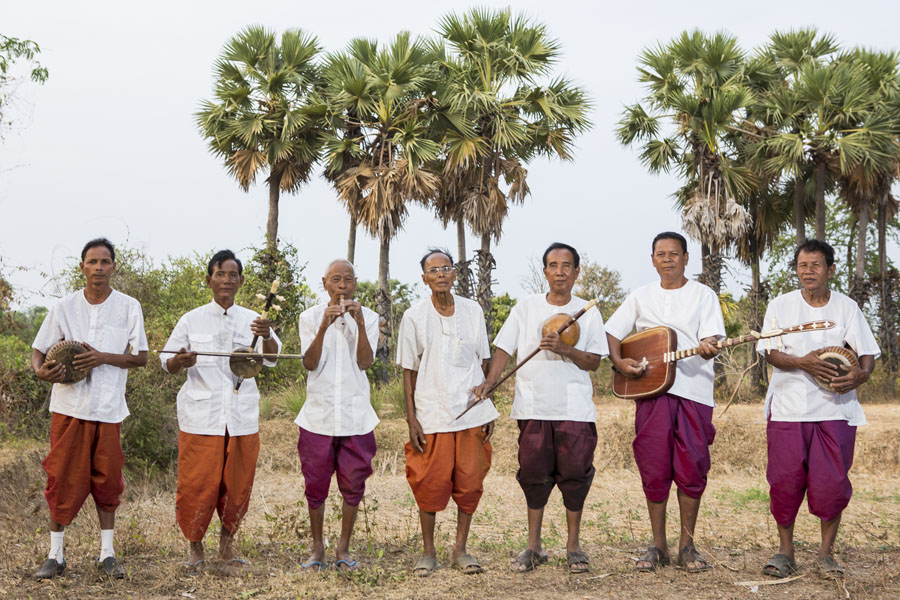
Those of us who’ve ever boarded a long-distance Cambodian bus probably think we know more about modern Khmer music than we deserve. But we’d be wrong. Because, although we tend to associate ‘heritage’ with dusty old scholars and hooky Angkor Wat souvenirs, there’s more to it than that. This month there’s a chance to discover Cambodia’s fragile cultural legacies, both ancient and modern – and the people saving them for the future.
Bringing the vinyl vibe of ’60s Cambodia back to life, for example, are The Underdogs, six young Khmers who met at the Music Arts School in 2012. Inspired by “the unforgettable sound of the golden age and also Dengue Fever and the Cambodian Space Project”, they’ve performed their mop-top tunes all over town. “It’s going to be an awesome event,” says frontman Samean ‘Sammie’ Ouk. “The Underdogs will rock you with the best Khmer old school songs and make you feel like you are dancing in the past!”
Contrast The Underdogs to warm-up act Master Hong Sun’s Ensemble. The elderly musicians from Kampong Speu beat accelerating rhythms, scratching out melodies on traditional stringed instruments. They are entreating the Areak, spirits who in days of yore helped the shaman (mehmut) when villagers fell sick. As part of the ritual-heavy performance the Areak are offered food and liquor too, not unlike a typical night out in Phnom Penh.
It’s quite a privilege to hear Areak music, notes Marion Gommard from Cambodian Living Arts. Barely influenced by the outside world, art forms like this are unique to Cambodia and there’s only a handful of practitioners still living.
It’s no secret that Cambodia’s heritage is particularly delicate. A generation of artists was decimated during the Khmer Rouge era. Vinyl recordings and acetate film rapidly deteriorate in these tropical climes, and in the Internet age are readily forgotten too. “Younger people ought to appreciate all these art forms and ensure they are not lost – and in turn become creators inspired by the past,” says Jamie Lee, who helps digitise priceless Khmer heritage at Unesco.
In 2005, the UN launched a World Day for Audiovisual Heritage and guardians of culture at the Bophana Centre, Cambodian Living Arts and Unesco have joined forces to organise this year’s event in Phnom Penh. Themed Musical and Performing Arts in Cambodia: Reviving Artistic Heritage, the aim is to breathe ‘a second life’ into everything from classical dance to jukebox favourites.
The event celebrates the visual as well as the audio. Since 2008, Suppya Nut and the Khmer Dance Project have been painstakingly recording reams of interviews with the dwindling population of surviving ‘masters’, from Khmer Royal Ballet directors to costume designers.
Revealed during New York’s Season Of Cambodia festival earlier this year, it’ll be the first time Nut’s work has been seen in this country and will be accompanied by a live dance performance. Guests at the free-entry event will get a CD of Khmer rock tracks remastered from the original vinyl. Look out too for the ’60s rock-styled couples trained to twist, mash and pony by former cinema starlet Dy Saveth (Miss Cambodia 1963). “It doesn’t need to be old to be heritage,” remarks Bophana Centre administrator Stanislas Touzet. Eat that, coach tour snobs.
WHO: Culture vultures to retro rockers
WHAT: Cambodian music and dance spanning the centuries
WHERE: Bophana Centre, #64 Street 200
WHEN: 4pm October 25
WHY: It doesn’t need to be old to be heritage
(PHOTO: Cambodian Living Arts / Kampuchea Party Republic)
